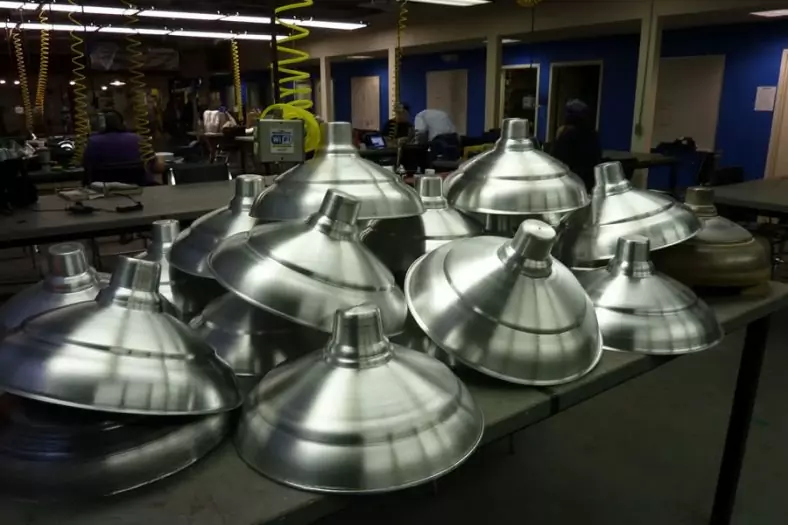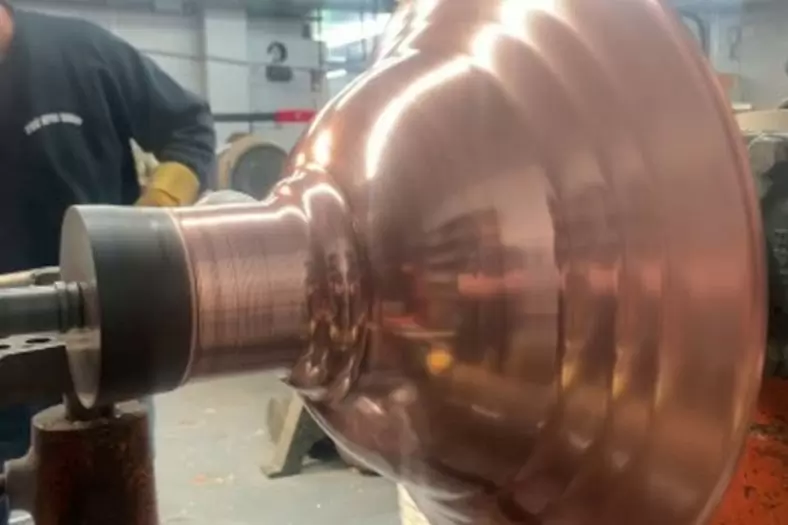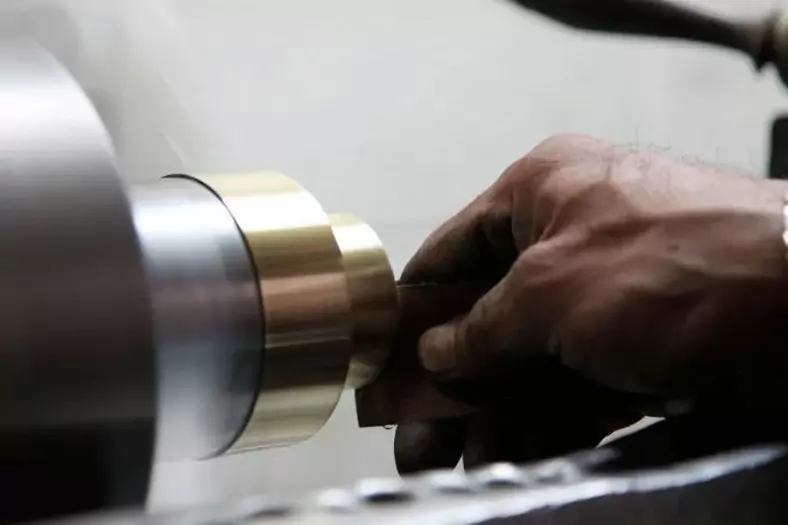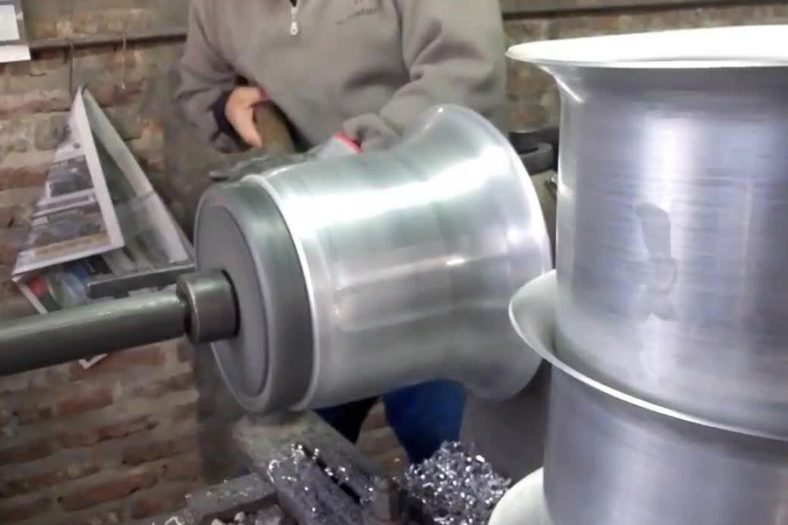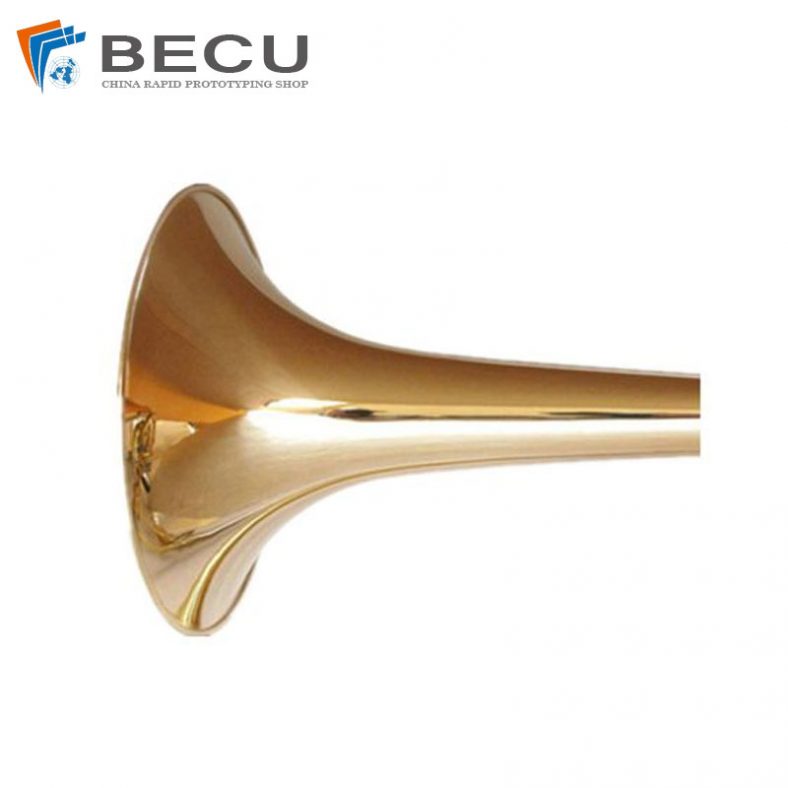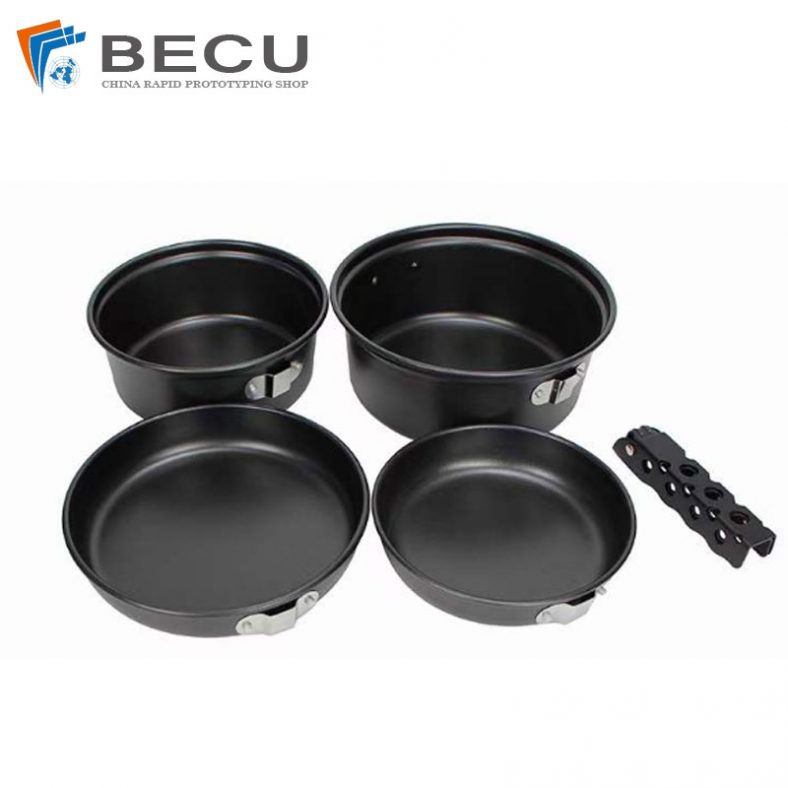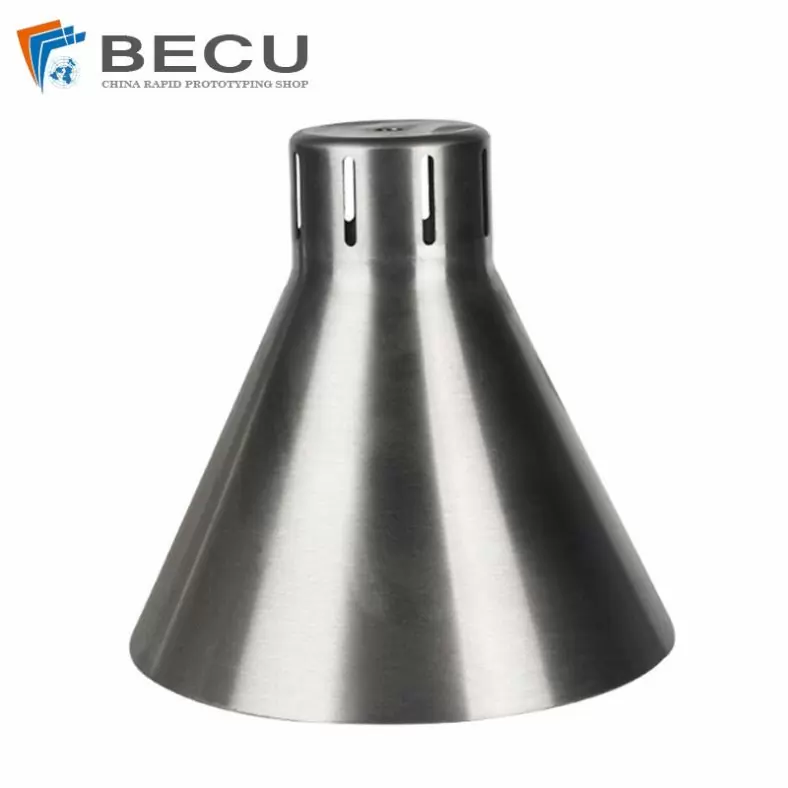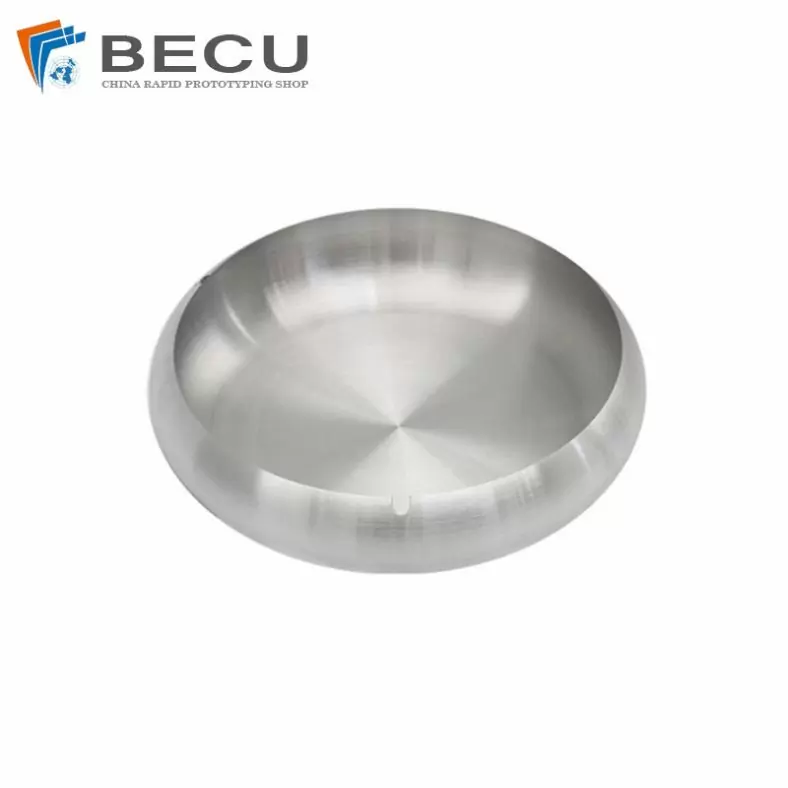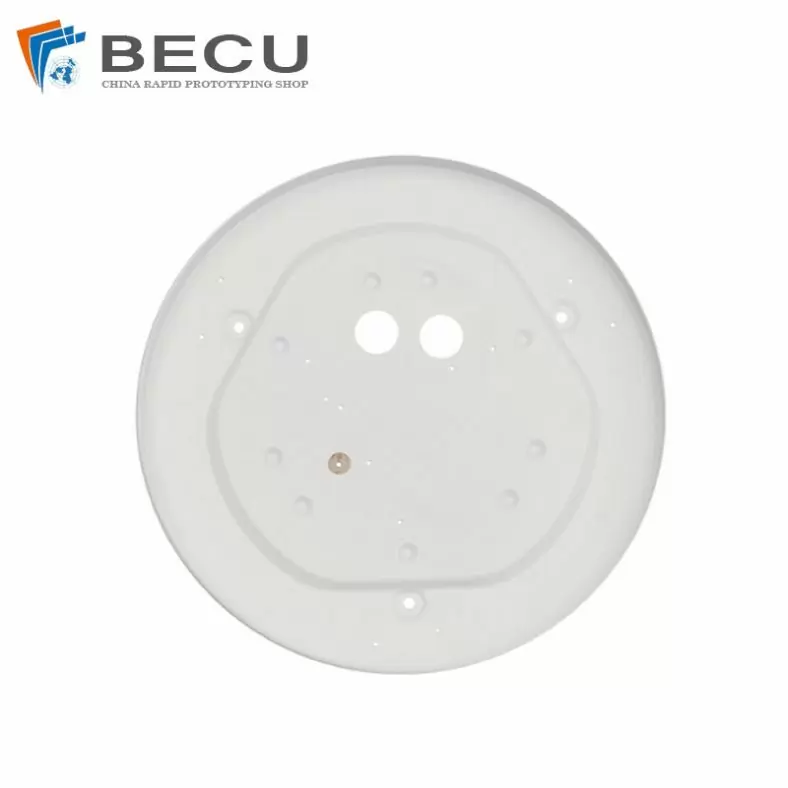According to historical records, more than 3,000 years ago during the Yin-Shang period of ancient China, the use of pottery wheels to create ceramic products was already in practice. By the tenth century, our ancestors, inspired by the principles of ceramic crafting, devised the manual metal spinning technique. This innovation allowed them to shape thin sheets of metals like silver and tin into a variety of containers, utensils, and ornaments such as plates, pots, bottles, and jars. Artifacts such as Tang dynasty silver bowls, cups, and tin wine vessels bear traces of this spinning technique, indicating that it dates back at least to the Tang period.
The ancient art of spinning, distinguished by its simplicity of tools, ease of preparation, and the lightweight, practical nature of its products, has endured the test of time. It has been preserved and passed down through the centuries, leaving remnants of its original techniques in various industries today, such as in the manufacture of enamelware, aluminum products, and lighting fixtures.
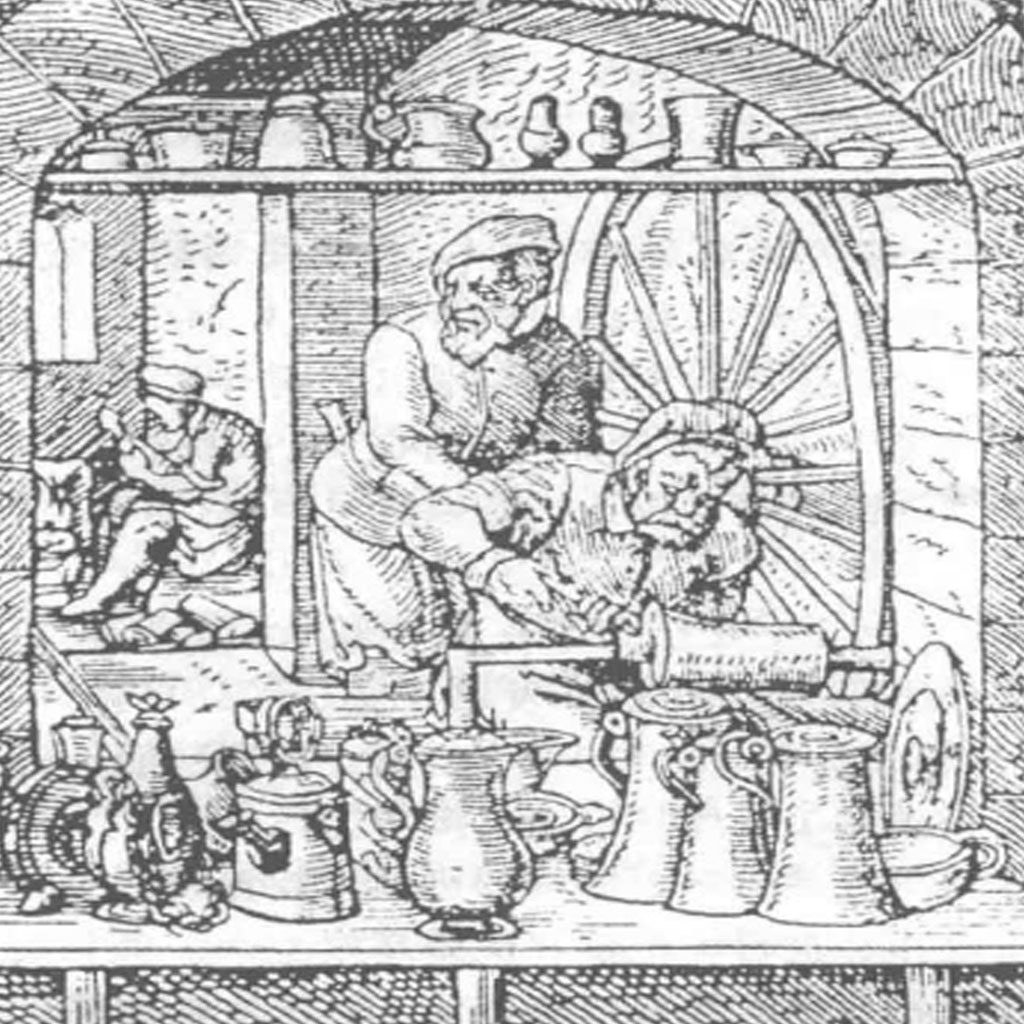
The Invention Of Spinning Machine
It wasn’t until the 13th or 14th century that this forming technology made its way to Europe, where it was similarly employed to craft various containers and utensils. Historical records from countries like England, Germany, Russia, and Spain also acknowledge that this metal forming technique originated in China.Figure 1-1 illustrates a medieval European woodcut, vividly depicting an ancient hand-spinning scene. Around 1840, a man named Jordan brought the spinning technique to the United States, where it was applied to civilian product manufacturing. In the late 18th century, the first spinning patent was registered in Germany.
The manual spinning technique, with its long history, represents the early stage of ordinary spinning, primarily used for forming thin-walled shells. However, its development was constrained by the physical limits and skill of the operator. Manual spinning was only suitable for shaping soft metals, small, thin-walled workpieces, and relied on simple tools and equipment.
Early hand spinning used a rolling stick as the primary tool. The stick’s small contact area with the material and its long lever arm made the process more efficient. Many Chinese crafts, aluminum products, enamelware, and lighting fixtures were shaped using simple tools and manual “rolling,” yielding high-quality products. In 1920, the United States employed hand spinning to process higher-strength materials, producing larger, more complex workpieces. Eventually, metal spinning wheels replaced wooden rods, marking a significant advancement as the friction between the wheel and the material transitioned from sliding to rolling, significantly reducing resistance and thus gaining widespread use.
For a long time, the ordinary spinning process lagged due to equipment limitations. Ancient spinning devices were powered by human labor, as shown in Figure 1-1, where one craftsman manually rotated a wooden wheel to spin a wooden core, while another used a wooden rod to press and shape the material.
With the advent of water and steam power, the technique began to evolve. As industrial technology progressed, especially with the invention of electric motors, hand-spinning machines adopted motor-driven spindles and cores, and spinning tools transitioned to metal wheels, greatly improving production conditions.
Before the introduction of electric spinning, the technology couldn’t keep pace with the development of die stamping, limiting its application to small-batch production of soft, thin-walled metal products with low efficiency and high labor intensity. However, the advent of electric spinning brought significant improvements, leading to technological breakthroughs and expanded applications.
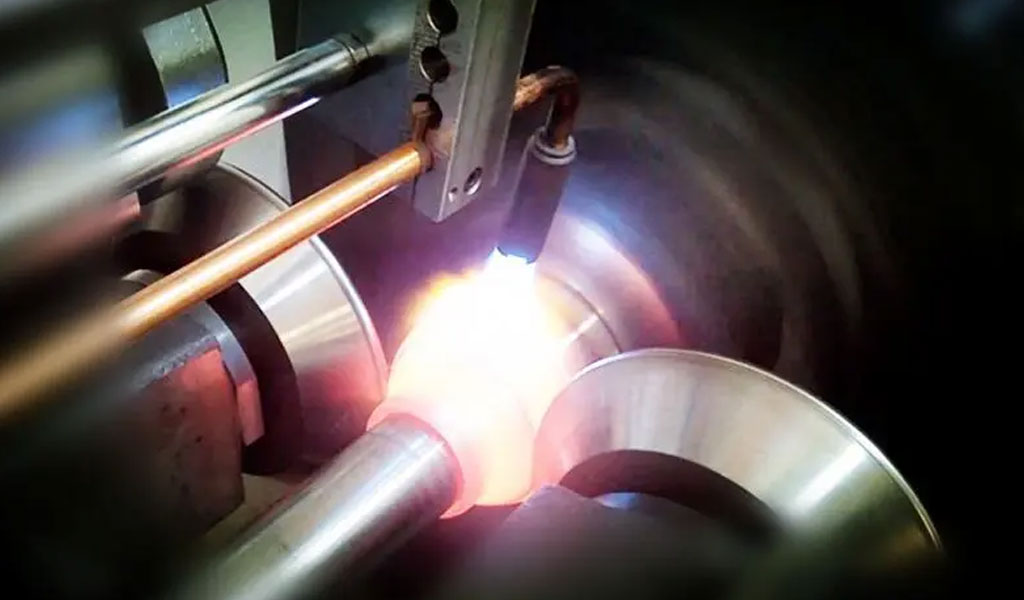
Since the mid-20th century, ordinary spinning has seen three major advancements:
- First, spinning equipment gradually became mechanized in the 1950s with the emergence of machines simulating hand spinning, driven by mechanical camming and hydraulic assist mechanisms, significantly reducing labor intensity.
- Second, in the 1960s and 70s, with a declining number of skilled spinners and increasing production demand, hydraulic transmission and automation in spinning equipment were introduced. This allowed for single-direction and multi-pass spinning, as well as bidirectional multi-pass feeding, controlled by semi-automatic (with manual loading and unloading) and fully automatic systems (including automated material handling). This represented a significant leap forward.
- Third, the rapid development of modern electronics and the widespread application of microcomputers in the late 1960s to 70s led to the development of numerically controlled (NC and CNC) systems and playback/teaching (PNC) systems in foreign countries, achieving modernization in ordinary spinning technology.
The playback/teaching spinning machine was first successfully developed by the Charles Taylor Company in the UK. Subsequently, German companies like Leifeld and Leico developed PNC series machines, while Switzerland’s M&M produced the HF series, Spain’s DENN produced the TORC series, and America’s Engle-Wil developed the T-M-T series. These playback spinning machines typically feature manual control input, and some can also use computer-aided design (CAD) for online or offline programming input and recording. Some models offer automatic correction of wheel-to-core gaps, core copying, protection, and fault diagnosis, optimizing the spinning process.
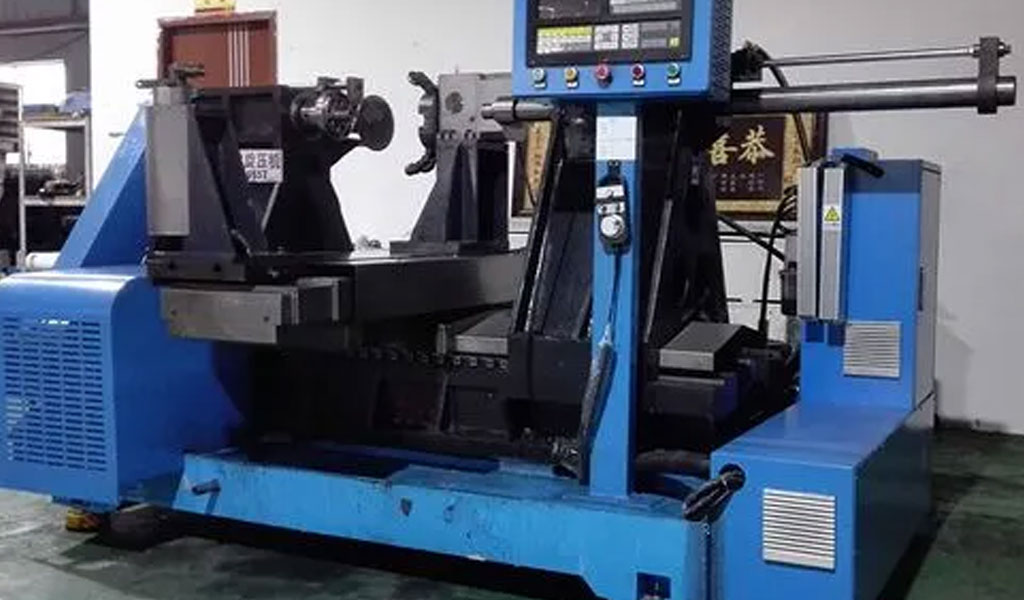
Germany’s BOKO and Italy’s ZANI developed the TAL-CNC series of spinning machining centers based on NC and playback machines. Germany’s Leico also developed the ARC-CNC series of spinning machining centers. These centers feature 4-6 CNC axes and combined CNC + PNC control functions, offering more flexible control with tool libraries featuring 6-position turret heads or tool changers, enabling multi-functional forming.
When paired with robotic loading and unloading devices or operated by robots, these CNC and playback spinning machines can be integrated into automated production lines for unmanned operation, enabling large-scale, high-quality, and efficient production.
For example, IMI-Range in the UK installed a robot-operated CNC spinning machine on a production line for copper water heater bottoms. The machine performs drawing, flanging, trimming, and beading operations, increasing productivity from 400 pieces per shift to 1,200 pieces per shift—a threefold improvement—while maintaining high quality and generating significant economic benefits.
From the above, it is evident that one key factor in the development of spinning technology is the transition from hydraulic to digital control in spinning equipment. The processing capabilities of general and specialized CNC spinning machines, including coordination between multiple wheels, the setting and adjustment of multi-wheel multi-pass motion trajectories, and various specific auxiliary forming functions, have greatly improved, along with machining precision, meeting the diverse needs of various applications.
China’s ordinary spinning technology and equipment have also made significant progress after years of effort, especially in the research and development of CNC and playback/teaching (PNC) spinning machines, reaching a high level and being widely applied.
Development Overview of Global Power Spinning Technology
Power spinning, developed from conventional spinning technology, began to be applied in civilian industries such as container and utensil manufacturing in European countries like Sweden and Germany around the time of World War II. With advancements in science and technology, particularly due to the rapid development of aerospace technology in the 1950s, spinning technology, especially power spinning, saw rapid development and application in many countries.

Broadly speaking, the development of global power spinning technology can be divided into four stages: the 1950s marked the initial development and application phase, the 1960s witnessed significant growth, the 1970s focused on the refinement, stabilization, and standardization of processes and equipment, and post-1980s, the technology advanced towards process improvement and the modernization of equipment with a shift towards CNC (Computer Numerical Control) technology.
According to a report (AD755876) from the United States in the 1980s, industrialized nations had developed approximately 200 specifications of spinning machines, many of which were standardized. At that time, the production of spinning equipment was mainly concentrated in countries such as the United States, West Germany, the former Soviet Union, Japan, the United Kingdom, and Switzerland, with the U.S. primarily producing heavy-duty, vertical equipment.
Development of Spinning Technology in the United States
The United States began using manual spinning around 1920. In 1953, the Pratt & Whitney Aircraft Engine Company and Lodge & Shipley collaborated to design and manufacture the first three specialized power spinning machines for processing aircraft parts. Over the next 20 years, with the development of emerging rocket, missile, and aerospace technologies, metal spinning technology found widespread application in both military and civilian industries. According to incomplete statistics from the time, the number of spinning machines produced in the U.S. reached 1,375 by 1958 and increased to over 2,000 by 1963. During this period, more than 15 companies in the U.S. were manufacturing spinning machines, with major players including Lodge & Shipley, The Cincinnati Milling Machine Company, and Hufford.
Lodge & Shipley designed and manufactured general-purpose power spinning machines such as the Floturn 12, Floturn 25, Floturn 40, Floturn 60, Floturn 70, and Floturn 80, as well as horizontal precision tube spinning machines. The Cincinnati Milling Machine Company produced models such as the Hydrospin 26, Hydrospin 32, Hydrospin 42, Hydrospin 60, Hydrospin 62, and Hydrospin 75. Hufford manufactured heavy-duty vertical spinning machines including the Hufford 60, Hufford 120, Hufford 166, and Hufford 171. Additionally, Eagleware produced the Autospin series of program-controlled and CNC spinning machines, also offering automated spinning production lines.
Most of the heavy-duty spinning machines in the U.S. were vertical, featuring unique structural designs with exceptionally large power and rigidity. Notable vertical spinning machines included the Floturn 80 (triple spinning wheels), Hydrospin 75 (dual spinning wheels), Hufford 60 (dual spinning wheels), Hufford 120 (dual spinning wheels), and the “Green Giant” (triple spinning wheels). The “Green Giant,” a vertical machine developed by 15 companies, remains the largest spinning machine in the world in terms of power (lateral spinning force of 5400kN, longitudinal force of 2710kN) and processing capacity (capable of spinning steel plates with a diameter of 6m and a thickness of 127mm, with workpieces ranging from 2200 to 4060mm in diameter and up to 6.1m in length). The equipment’s size (total height of 12.2m) and weight are unmatched. Another notable machine is an internal spinning machine capable of forming rocket engine casings with a diameter of 3050mm and a height of 3.5m.
Due to the technological and economic advantages of power spinning, it was widely adopted in U.S. military industries during the 1950s and saw rapid development.

Major companies like Boeing, Grumman, Lycoming, Solar, Marquardt, Ford, and General Electric utilized power spinning for mass production of spun parts. Materials used in spinning included aluminum alloys, carbon steel, alloy steel, stainless steel, high-strength steel, and refractory metals. The aerospace industry employed spinning to produce jet engine components, such as casings, support cones, turbine shafts, flame tube liners, and exhaust nozzles for models like the J57 and J75.The emerging space industry used spinning for manufacturing satellite bodies, missile bodies, conical parts, hemispherical fuel container heads, cylindrical combustion chambers, Laval nozzles, and parabolic diffuser-type engine nozzles.
In the 1960s, power spinning technology further developed and was applied in the U.S. For instance, Lodge & Shipley processed seamless liquid oxygen delivery pipes with a diameter of 635mm and a maximum length of 30m for the Apollo spacecraft’s booster rocket engine. General Electric produced 1600mm diameter, 2700mm long shells for the “Minuteman” intercontinental missile. NTW Missile Engineering used internal spinning to form 3000mm diameter, 3460mm long shells for the “Titan” III C missile. General Electric also mass-produced turbine shafts for J79 aircraft engines, engine cowls for B58 bombers, and bomb rack cones for AAS aircraft. Additionally, many military products such as armor-piercing shells, rocket launch tubes, long-range coastal gun barrels, naval torpedo casings, and radar parabolic antennas were produced using spinning. Wang Chang Company employed hot spinning to process tungsten and molybdenum tubes, and tension spinning for long conical tubes used in helicopters and streetlights. The U.S. also conducted extensive, systematic research on spinning processes, theoretical analysis, and experimental studies, resulting in numerous academic papers and technical patents.
At the time, other countries such as West Germany, the former Soviet Union, the United Kingdom, and Japan also heavily invested in research and development of spinning technology, including processes and equipment, material spinability, deformation mechanisms, physical properties of spun parts, defect phenomena, and mechanical analysis and experimental studies of spinning deformation.
Development of Spinning Technology in Germany
Germany’s spinning technology has developed rapidly over the past century, particularly since the 1950s. Companies such as Leifeld and Leico have designed and manufactured dozens of series of spinning equipment products, which are now among the most complete, comprehensive, and advanced in the world, selling to over 50 countries and regions. German companies specializing in spinning equipment include Leifeld, Peko, WF, and the emerging Leico.
German spinning machines are mainly medium and small-sized general-purpose and specialized machines, mostly horizontal. Later, heavy-duty spinning machines such as the PLB1800, PNC1800, BOD47, BOD58, and vertical VDM4000, VDM5000, and VDM6000 models were developed, along with a series of CNC and PNC (Programmable Numerical Control) spinning machines in the 1970s. Leifeld and Leico produced general and power spinning machines with series like PLB, APED, ST, AFM, VRM, SE, ATM, AUS, FBF, PR, BOD, VDM (vertical, for heads), EN (for gas cylinders), AFM (for wheel steels), ST-DK (for wheel spokes), VRM (for belt wheels), FBF (for packaging drums), ST-CNC (three-wheel CNC), and PNC (programmable numerical control). Peko’s main series included D-H (single wheel at the front), D-RH (single wheel at the rear), D-HRH (dual wheels front and rear), D-CNC (single wheel CNC), 2D (dual wheels), 3D (three-wheel hydraulic profiling), 3D-CNC (three-wheel CNC), 3D-V (three-wheel vertical), and P111b (dual wheels).
In the late 1980s, Germany’s Thyssen Machinery Manufacturing Company designed and manufactured a new type of vertical CNC dual-wheel heavy-duty spinning machine for processing large-diameter precision rocket shells. Its main technical parameters included: processing diameter range of 2400 to 3200mm, spindle speed of 2.4 to 24r/min, radial spinning force of 1600kN, axial spinning force of 800kN, drive power of 1300kW, radial feed speed of ≤15mm/min, and axial feed speed of 0.2 to 4mim/r. This 16-axis CNC machine, with four pairs of spinning wheels, was capable of processing D6AC high-strength steel workpieces with a blank diameter of 3070mm and wall thickness of 80mm, achieving a thinning rate of 90% (80→46mm, 46→8mm) after two passes without intermediate annealing. The features of this equipment included the absence of a core mold, high precision, high thinning rate, high efficiency, and low processing cost.
Development of Spinning Technology in Spain
The Spanish company DENN was founded in 1885 and has over 100 years of history in manufacturing spinning equipment, making it one of the earliest specialized spinning equipment manufacturers in the world. Currently, DENN offers a comprehensive and complete range of spinning machines, including the TORC series (conventional spinning), RLE series (dual-wheel power spinning), RC series (three-wheel power spinning), CTA series (hot spinning for gas cylinders), and MP series (wheel spinning). Among these, the company’s latest generation of CNC (Computer Numerical Control) equipment is included. The TORC series CNC+PNC machines feature both CNC and programmable numerical control (PNC), allowing input via manual handle, external computer CAD/CAM programming, electronic light pen drawing, and imaging display. Additionally, they include features such as core mold copying, safety protection, and fault self-diagnosis. Most of DENN’s spinning machines are horizontal and predominantly medium to small-sized.
Development of Spinning Technology in Japan
Since the 1950s, Japan has also placed great emphasis on the development of spinning technology. Reports indicate that the main companies in Japan designing and manufacturing spinning machines include Terada Iron Works, Mitsubishi Heavy Industries, Fuji Machine Manufacturing, Mitsui & Co., Nippon Spindle Manufacturing, and Japan M Company, among others. Spinning processes and equipment are widely used across various industrial sectors in Japan. According to a survey by the Spinning Division of the Japan Society for Technology of Plasticity, more than half of the products in the surveyed companies were processed using spinning methods. Additionally, Japan has conducted extensive research on spinning processes, deformation theory analysis, and experimental studies.
Development of Spinning Technology in Russia
Since the 1950s, the former Soviet Union has also heavily invested in the development of spinning technology, conducting significant research on processes and theoretical analysis, and exponentially increasing the number of spinning machines to meet the needs of its aerospace and military industries. In the 1950s, the Kyiv Machine Tool Plant and Tbilisi Machine Tool Plant produced spinning machines such as the 3P-53 and TT-53 models, respectively. The Institute of Construction, Road, and Public Machinery Manufacturing Process Design also designed and manufactured semi-automatic spinning machines like the nII0-2, nIK-1, nIK-2, and 801·079 models. In the 1970s and 1980s, a trend in the development of spinning technology was to convert existing semi-automatic lathes and CNC machine tools into spinning machines, rather than designing and manufacturing new, expensive automatic spinning machines. This approach had several advantages: it utilized existing machinery, avoiding the need to design and produce new machines, thus saving costs; CNC lathes could be relatively easily converted into spinning machines by simply changing the programming and process equipment; and the programs were written in digital form, with the production preparation work primarily handled by engineers, a process that could be assisted by computers.
It is well known that Russia is a world leader in aerospace and military technology, but formal reports on spinning equipment, especially large-scale spinning machines, are scarce.
Development of Spinning Technology in Switzerland
The Swiss company Jenny Presses, Ltd., designed and manufactured spinning machines in the 1960s and 1970s, mostly single-wheel hydraulic profiling machines. Later, they also produced heavy-duty, three-wheel power spinning machines. Reports indicate that their equipment had excellent rigidity, making it suitable for spinning under heavy loads. In the 1970s and 1980s, Swiss company C. Haeusler also designed and manufactured the HBM-Y series of fully hydraulic head flanging spinning machines, capable of processing flat-bottomed heads, 2:1 elliptical heads, and other pressure vessel heads. These machines could handle steel blanks with a thickness of 2.4 to 3.2mm, and with heated spinning, the blank thickness could reach 102mm, with a maximum head diameter of 7315mm.
Development of Spinning Technology in Italy
Italian companies Boldrini and Faccin began designing and manufacturing two-step head spinning machines in 1959. In the 1970s, Boldrini produced various spinning machines, including models such as RIBO10S, RIBO18, RIBO24, RIBO25, and RIBO30. Faccin’s PPM series included 4 to 5 types of drum presses, while the BF series included 8 to 9 types of flanging machines, with a maximum processing diameter of 7000mm and a maximum hot spinning wall thickness of 150mm. A typical head size was 4600×90mm. China Petrochemical Machinery Manufacturing Plant has imported more than 20 sets of these two-step head spinning machines.
In summary, the development of metal spinning technology worldwide has been rapid, with both equipment and processes becoming increasingly mature and refined. Spinning technology is now widely adopted in many countries, with spun parts reaching diameters of 3 to 5000mm, wall thicknesses of 0.1 to 200mm, length-to-diameter ratios exceeding 20, and diameter-to-wall thickness ratios greater than 750. Cylindrical spun parts have a maximum diameter of 7600mm and a maximum weight of 60 tons.
Hot spinning processes can significantly expand the range of processing capabilities, enhance equipment processing capacity, and meet the demands of forming difficult-to-deform metals. Worldwide, machines capable of cold spinning 25mm thick blanks can hot spin blanks up to 137mm thick. For the same workpiece, the spinning force in hot spinning is nearly halved. Materials such as titanium alloys, magnesium alloys, silver, niobium, molybdenum, and tungsten alloys can all be hot-spun.

Development Spinning Technology In China
China is the birthplace of conventional spinning technology, which has a long history of development. This traditional process is still applied in industries such as aluminum products, enamelware, lighting fixtures, cloisonné, and musical instruments.
Although most operations are performed manually on relatively simple equipment, the process remains an indispensable method for producing thin-walled products due to the simplicity and ease of preparing tools and molds, as well as its lightweight and adaptable nature.
However, this outdated state needs to be improved through the collective efforts of engineers and technicians specializing in spinning technology.
The development of spinning technology in China truly began in the mid-1960s. The first 20 years, from the mid-1960s to the mid-1980s, were the initial stage. During this period, China began researching thinning spinning technology. Initially, the 625 Institute of the Ministry of Aviation conducted research on powerful spinning processes and equipment, mainly applying this technology to the production of aviation products. Soon after, the Beijing Nonferrous Metal Research Institute and the Xi’an Heavy Machinery Research Institute also began researching this technology, primarily for manufacturing special metallurgical products like aviation, missiles, and rockets. At the same time, to meet the country’s urgent needs, a batch of medium and large electric-hydraulic combined control spinning equipment was developed, some of which are still in use today, playing a significant role. Examples include equipment for processing aircraft auxiliary fuel tanks, missile casings, nozzles, periscope tubes, and large-diameter seamless aluminum tubes. Subsequently, this technology was gradually promoted to the defense, nuclear energy, and electronics industries. Units like the Changchun 55 Institute of Weapons, Northeast Heavy Machinery Institute, Qinghai Heavy Machine Tool Factory, Harbin Institute of Technology, and Beijing University of Aeronautics and Astronautics also began developing this technology, focusing on providing spinning equipment and processes for weapon spinning products, pressure vessel heads, and more. Significant results were achieved in heating spinning for forming powder metallurgy sintered materials and cast materials, as well as for refractory metal products like tungsten, molybdenum, and titanium and its alloys. During this period, the development of spinning technology in China was mainly centered on powerful spinning and military products. Spinning technology established its position and role in the national economy, complementing and paralleling conventional forging production due to its irreplaceability and advantages in processing specific materials and products.
From the mid-1980s to the present, over 30 years have been a period of transformation and development for China’s spinning technology. During this time, the focus shifted from powerful spinning to a balance between powerful and conventional spinning, and from mainly military products to a combination of military and civilian products. Spinning equipment control also transitioned from electric-hydraulic combined control (characterized by hydraulic profiling) to digital control. In the field of conventional spinning, hydraulic profiling with programmable control emerged first, leading to automatic spinning machines with reciprocating and multi-pass oscillation, marking a significant leap in conventional spinning, moving away from the labor-intensive manual operations, and greatly improving product quality and production efficiency. In the development of electric-hydraulic program-controlled conventional spinning machines, models like PX-1, SY-2, and SY-2A were developed by the Beijing 625 Institute, while the Fujian Mechanical Science Research Institute developed the PXC series (13 models), and the Changchun 55 Institute developed the PX series. These machines, equipped with hydraulic profiling and PLC (programmable logic controllers), are used in industries like lighting fixtures, kitchenware, separators, and fans. After 2000, Beijing Jinst Technology Co., Ltd. and Qingdao University Heavy Machinery Manufacturing Co., Ltd. successfully developed CNC and PNC conventional spinning machines; Guangdong Hui Dongguan Bo BE-CU control spinning machine Co., Ltd. developed over 50 models of CNC conventional, powerful, and special spinning machines, with custom machines tailored to customer needs, covering over 30 different industries and having nearly ten thousand types of product forming experience. These advanced, cost-effective devices are well-received by users, meeting domestic needs and also exported, reversing the previous reliance on foreign imports. This indicates a new breakthrough in China’s conventional spinning technology, achieving preliminary modernization and narrowing the gap with advanced international levels.
In addition to military applications, conventional and powerful spinning technologies are widely used in many civilian industries, producing various mechanical equipment casings, covers, and parts, hydraulic support cylinder bodies for mining, printing machine rollers, aluminum drums for copiers, streetlight poles, gas cylinders and bottles, large container heads, automotive wheel spokes and rims, lighting fixtures, household containers and utensils, baseball bats, javelin shafts, cloisonné copper blanks, and small trumpet mouths, among thousands of other products. Furthermore, specialized enterprises focusing on spinning product production have been established domestically, such as those producing pressure vessel heads, automotive spinning products (wheel spokes, rims, pulleys, silencers, etc.), and high-pressure electrical switch accessories.
Examples of Typical Spinning Products and Their Applications Over the Past 30 Years
Trumpet Mouthpieces
For a long time, trumpet mouthpieces in China were produced using manual conventional spinning techniques, resulting in mouthpieces with thick rims, thin walls, and subpar sound quality. In the late 1980s, a musical instrument factory in Beijing developed a combined technology of thinning spinning and conventional spinning, achieving mouthpieces with thin rims and thick walls. The sound quality of these trumpet mouthpieces was reported to exceed that of some imported brands. Currently, this product still has a certain volume of exports.
Gas Cylinder Linings
Recently, aluminum alloy gas cylinders with composite material winding have shown great potential and growing demand in automotive, mining, firefighting, medical, and even mountaineering and diving applications due to their light weight and safety. These aluminum alloy cylinders are formed by thinning spinning of pipe materials or pre-formed blanks, followed by conventional spinning processes for heat shrinking and sealing. Production lines for these cylinders have been established in several locations in China for mass production. Additionally, vacuum stainless steel thermal cups and teapots, which are smaller but similar in shape, have become popular new products with significant demand. Moreover, steel gas cylinders used in industrial applications are also a large-volume product, with several domestic manufacturers developing and producing various specifications, including the largest with a diameter of 600 millimeters and a length of 12 meters, serving as large-scale storage solutions.
Pulleys
Pulleys are used in automobiles to drive components such as shafts, water pumps, compressors, generators, air conditioners, steering systems, and fans. They are also used in agricultural machinery, textile machinery, and washing machines. With the rapid development of the national economy, the annual demand for pulleys has increased from millions in the 1990s to over ten million today. Spun pulleys, with their reduced weight, material savings, high precision, surface quality, and good balance, have been successfully promoted and widely applied domestically, replacing traditional cast iron machining, sheet stamping, and hydraulic bulging methods. Spun pulleys come in various types, including folded, split, and multi-V groove types, and their combinations, satisfying domestic needs and some exports. China has developed series of programmable and numerical control spinning machines, mostly vertical, reaching international advanced levels. There are now over a hundred such machines nationwide, processing over ten million parts annually with an output value exceeding one billion yuan. Due to the increasing domestic automobile production and the need for parts exports, high-quality pulley products are in high demand.
Wheels
Spun steel wheels (comprising spokes and rims) are primarily used in heavy-duty trucks and buses, while spun aluminum wheels (both combined and monoblock types) are increasingly used in passenger cars. These new wheels, achieved through thinning spinning, enable designs with equal strength (economical sections), reducing weight (by 10-15%), extending service life, saving energy, and enhancing load capacity, resulting in significant technical and economic benefits. Currently, enterprises in Shandong, Hebei, Jiangsu, Fujian, Zhejiang, Hubei, and Jilin have introduced spinning production lines for steel wheels to meet domestic and international demands. Monoblock aluminum wheels are also produced using a combination process of split spinning, thinning spinning, and conventional spinning, with products mainly for export. The annual production of spun wheels nationwide now exceeds one million sets, with an output value reaching several billion yuan.
Heads
Large heads are essential in various industries, including petrochemical, power boilers, metallurgy, construction, railway tankers, textiles, food, and urban public utilities. The estimated annual domestic demand is over 50,000 to 100,000 pieces, with some requiring local production due to transportation difficulties. Large head spinning primarily involves two-step forming (plate blank pressing and spinning flanging) and one-step forming (multiple passes of conventional spinning), offering advantages like saving large molds, reducing mold storage space, and shortening trial production cycles, thus replacing traditional hot pressing and welding methods. Currently, China has developed a series of three-step spinning equipment, with the largest heads having a diameter of up to 7.5 meters, benefiting projects such as the South-North Water Diversion, 2008 Beijing Olympics venues, and Shenzhou 2 ground engineering. One-step spinning offers reduced workpiece transfers, shorter processing times, and reduced equipment footprint. The largest equipment in this series can process diameters up to 5 meters. Including imported equipment, China now has over 60 large head spinning machines, with an annual output value exceeding 1 billion yuan, contributing to national economic development.
Additionally, over the past 30 years, the application of spinning technology in China’s military industry has expanded, including the spinning of various large-diameter ultra-high-strength steel and high-strength aluminum alloy casings. Recently, spinning of β-titanium alloy cylinders and large-diameter aluminum alloy ring-reinforced shells and cylindrical shells has been completed. The former uses external spinning with composite molds, while the latter employs internal spinning methods.
The Shapes Achieved Of Metal Spinning Parts
Simple shapes are easy to make in less time. But for complex shapes, it requires more time because it increases steps as per the block shape.
In addition to metal spinning, Be-cu.com also offers in-house tooling, welding, abrasive polishing and hydroforming, helping to drive down your costs and streamline production. Quicker turnaround times and lower costs are two of the most attractive advantages of metal spinning. The ability to form very thick components and large diameters with uniformity and high quality at low and high quantities, are more appealing reasons to consider metal spinning.To find out if metal spinning would be beneficial for your application or end product, contact us today.
- Domed
- Flanged
- Domed with flange
- Dished
- Semi elliptical
- Hemisphere
- Flanged, dished and flued
- Trumpet
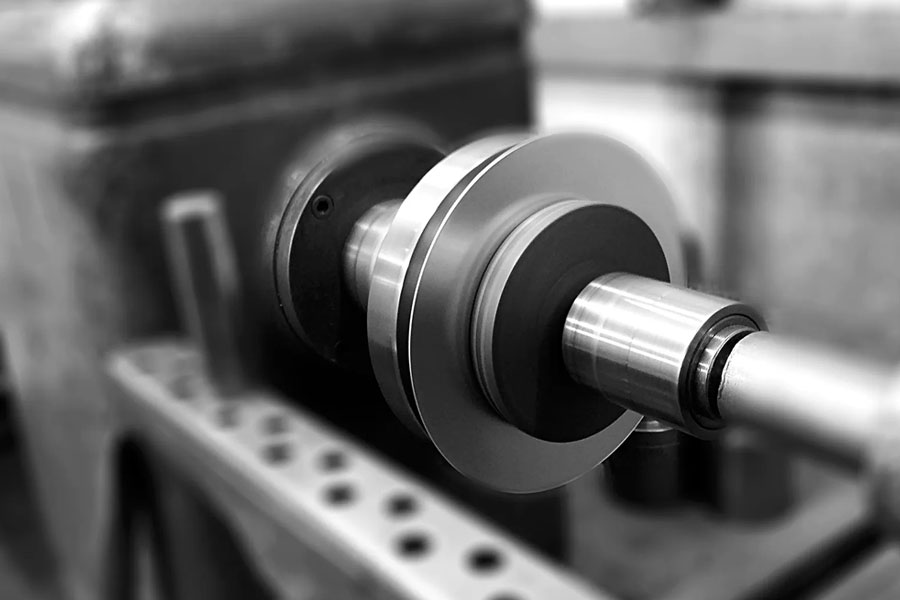
The Detail Of BE-CU Metal Spinning Company

At Be-cu.com, we use a variety of materials for metal spinning such as cold rolled steel, hot rolled steel, aluminum spinning, stainless steel spinning, brass, copper spinning and exotic metals such as titanium and inconel. Be-cu Metal Spinning Section specializes in the forming of stainless steel. With our automated metal spinning lathes and the capabilities of our deep drawing, stamping and welding equipment, our ability to form your part to your specifications and within your budget are realistic. Be-cu Metal Spun Company has over 30 years of metal forming experience and has used the large metal spinning technology for a variety of industries such as aerospace, automotive, military, ordnance, plastics, lighting, pharmaceuticals, dairy, etc…
We have engineers on staff with metal spinning expertise to help guide you on designing a custom part and choose the optimal process to produce high quality spun parts at a competitive and affordable price. Tooling is custom made to form parts to your configuration.

